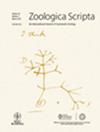Molecular phylogenetics of the superfamily Stromboidea (Caenogastropoda): New insights from increased taxon sampling
IF 2
2区 生物学
Q2 EVOLUTIONARY BIOLOGY
引用次数: 0
Abstract
The superfamily Stromboidea is a clade of morphologically distinctive gastropods which include the iconic Strombidae, or ‘true conchs’. In this study, we present the most taxonomically extensive phylogeny of the superfamily to date, using fossil calibrations to produce a chronogram and extant geographical distributions to reconstruct ancestral ranges. From these results, we confirm the monophyly of all stromboidean families; however, six genera are not monophyletic using current generic assignments (Strombidae:蛙足目超科的分子系统学:增加分类群取样的新发现
海螺超科(Stromboidea)是一个由形态独特的腹足类动物组成的支系,其中包括标志性的海螺科(Strombidae)或 "真海螺"。在这项研究中,我们利用化石校准来制作年代图,并利用现存的地理分布来重建祖先的分布范围,从而提出了迄今为止该超科在分类学上最广泛的系统发生。从这些结果中,我们确认了所有石龙子科的单系性;然而,根据目前的属分配,有六个属不是单系的(石龙子科:Lentigo、Canarium、Dolomena、Doxander;Xenophoridae:Onustus、Xenophora)。在蛛形目内,分析结果表明印度-西太平洋(IWP)支系是东太平洋/大西洋支系的姐妹支系,同时又是第二个更大的印度-西太平洋支系的姐妹支系。我们的研究结果还表明,中新世出现了两次长尾狒狒的多样化,长尾狒狒起源于哲罗纪/印度洋/西太平洋--这两点都得到了化石记录的支持。然而,分化时间估计与化石记录之间的冲突值得进一步探讨。利用 COI 条形码基因进行的物种划分分析支持几种分类学上的变化。我们将Euprotomus aurora与Euprotomus bulla、Strombus alatus与Strombus pugilis、Dolomena abbotti与Dolomena labiosa、Dolomena operosa与Dolomena vittata同名。我们在 Terebellum terebellum、Lambis lambis、"Canarium" wilsonorum、Dolomena turturella 和 Maculastrombus mutabilis 中发现了隐性物种群。我们将 Rimellopsis laurenti 恢复为一个种(之前与 R. powisii 同名),并承认 Harpago chiragra rugosus 和 Lambis truncata sowerbyi 为有效种。最后,我们建立了几个新的组合,使 Lentigo、Dolomena 和 Canarium 成为单系:Lentigo thersites、Dolomena robusta、Dolomena epidromis、Dolomena turturella、Dolomena taeniata、Dolomena vanikorensis、D. vittata、"Canarium" wilsonorum、Hawaiistrombus scalariformis、Maculastrombus mutabilis、Maculastrombus microurceus。
本文章由计算机程序翻译,如有差异,请以英文原文为准。
求助全文
约1分钟内获得全文
求助全文
来源期刊

Zoologica Scripta
生物-动物学
CiteScore
5.60
自引率
0.00%
发文量
52
审稿时长
>12 weeks
期刊介绍:
Zoologica Scripta publishes papers in animal systematics and phylogeny, i.e. studies of evolutionary relationships among taxa, and the origin and evolution of biological diversity. Papers can also deal with ecological interactions and geographic distributions (phylogeography) if the results are placed in a wider phylogenetic/systematic/evolutionary context. Zoologica Scripta encourages papers on the development of methods for all aspects of phylogenetic inference and biological nomenclature/classification.
Articles published in Zoologica Scripta must be original and present either theoretical or empirical studies of interest to a broad audience in systematics and phylogeny. Purely taxonomic papers, like species descriptions without being placed in a wider systematic/phylogenetic context, will not be considered.
 求助内容:
求助内容: 应助结果提醒方式:
应助结果提醒方式:


